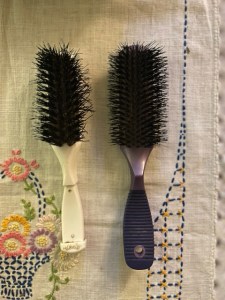A good hairbrush has always been important to me. You might ask why: At present, my hair reaches just above my ankles. Usually, the first question people ask me is, “When was the last time you cut your hair?” In 2015, when my brother Miles (author of Sphere of Influence: An Approach to Self-Defense) committed suicide, I cut my hair for him. It just felt like the right thing to do. While it felt strange for a while not feeling my hair touching the backs of my calves, it’s returned to its previous length. Still, it was never so short that I didn’t need my trusty hairbrush.
I still have my first hairbrush….
I was raised not to waste. (I write a little bit about this in a poem I’m currently trying to get published, a poem called “Miles,” which was recently a semifinalist in the Sandy Crimmins National Prize for Poetry.)
When I was in seventh grade, I saw a hairbrush lying in the lobby at Indian Valley Middle School. It was white, with a green band around the middle. I picked it up and tucked it into my backpack. When I mentioned it to classmates, they grimaced and said it was gross and I replied with, “What? I rinsed it off in the bathroom.”
Despite their warnings of lice, nothing ever happened, and I’ve used the hairbrush ever since. (I’m 36 now. It’s in the picture. Although, it’s lost the green band.)
My grandmother’s hairbrush….
When my Grandma Polly passed away last April, one of her many belongings I kept, and treasured, was her purple hairbrush with black bristles. It just so happens my white hairbrush from Middle School is a bit warn out (surprised?) so Grandma’s brush is a good replacement.
I don’t know how old the hairbrush is. It could be 15 years old or 20, or maybe not even 10. Grandma’s brush is on the right in the photo below. Mine, from middle school, is on the left.

I’ve learned telling the exact age of a hairbrush can be difficult….
Today, hairbrushes are made of plastic or wood with bristles made of some type of plastic (I imagine the bristles are plastic but do correct me if I’m wrong). Now that I’m looking for more and more ways to use less plastic, I’m not sure how to handle hairbrushes or toothbrushes, for that matter. Even some bamboo toothbrushes still have nylon bristles. Others have bamboo bristles which are soaked in water before use.
I’ve always been committed about using something until it falls apart, because I’ve never been able to stop thinking about where it ends up after I’m done with it. I suppose that’s one of the reasons I like vintage items: They seem to last a lot longer, or they wouldn’t have made it into my possession in the first place.
Here’s a beautiful set that I figure is probably from the 1940s, due to the nylon bristles, but I’m not absolutely sure. It has a nice weight to it.

But what are the bristles made of on vintage hairbrushes?
It’s a mix: Nylon was first commercially made in a toothbrush in 1938. I have a couple vintage hairbrushes that say “Nylon USA” on the easy-to-remove and clean brush area. So, while the body of the brush and its matching mirror are made of metal materials, the brush itself is made of plastic. From the research I’ve done, I’ve concluded that I have a couple of sets from the 1940s. Here’s another:

In the days of antiquity, brushes were made from animal hair, porcupine quills and shells while the handles were made of wood, bronze or copper.
The earliest patent for a hairbrush in the United States was in 1854. Until the invention of nylon, the bristles were made of animal hair, usually boars’ hair. Interestingly, I discovered brushes are still made with boars’ hair, and you can find them online.


There are also hairbrushes made of ivory, but they’re illegal to sell in the United States. (While I believe there are exceptions for antiques, I think it has to be appraised.) Here’s my ivory hairbrush with boars’ hair bristles, with my Bakelite brush with boars’ hair bristles.
Do I actually use these hairbrushes?
Yes! Although, I’ve found the Bakelite brush has lost a few bristles…so I go a bit easier on it.
Finally, here’s my favorite: A set my fiancé, Walter, gave me for our two-year anniversary….

I’m always happy to hear about history, so if there’s something I left out, please comment and let readers know.
Next time you brush your hair, consider the fascinating history of this simple implement!





































 At the end of the semester in hybrid theory class, each student had to do a presentation. Mine was full of objective correlatives. I presented on This Victorian Life by
At the end of the semester in hybrid theory class, each student had to do a presentation. Mine was full of objective correlatives. I presented on This Victorian Life by